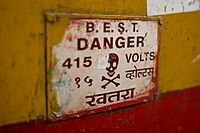Skull and crossbones
| ☠🕱 | |
|---|---|
Skull and crossbones | |
| In Unicode | U+2620 ☠ SKULL AND CROSSBONES U+1F571 🕱 BLACK SKULL AND CROSSBONES |
| Related | |
| See also | U+2623 ☣ BIOHAZARD SIGN U+2622 ☢ RADIOACTIVE SIGN |
A skull and crossbones is a
In modern contexts, it is generally used as a hazard symbol, usually in regard to poisonous substances, such as deadly chemicals.[1]
It is also associated with
Military use
The skull and bones are often used in military insignia, such as the
Since the mid-18th century, skull and crossbones insignia has been officially used in European armies as symbols of superiority. One of the first regiments was the
Symbol for poisonous substances
The skull and crossbones has long been a standard symbol for poison.
In 1829,
In the 1870s poison manufacturers around the world began using bright cobalt bottles with a variety of raised bumps and designs (to enable easy recognition in the dark) to indicate poison,[10] but by the 1880s the skull and cross bones had become ubiquitous, and the brightly coloured bottles lost their association.[11]
In the United States, due to concerns that the skull-and-crossbones symbol's association with
Gallery
-
A skull and crossbone arrangement in the Sedlec Ossuary, Czech Republic.
-
Skull and crossbones as a charge in heraldry on the coat of the 8th Lusitania Cavalry Regiment
-
An early 17th-century "plague panel" from Augsburg
-
High voltage sign from Saudi Arabia
-
A typical Jolly Roger ensign
See also
- Danse Macabre – Artistic motif on the universality of death
- Death's Head – Fictional character in Marvel Comics
- Hazard symbol – Warning symbol on locations or products
- Human skull symbolism – Attachment of symbolic meaning
- Mr. Yuk – Label that indicates poisonous material
- Ossuary – Container for dead remains
- Skull art – Use of skulls and skeletons in art
- Skull and Bones – Secret society at Yale University, US
- Totenkopf – German symbol for skull and crossbones
References
- ^ a b "Dictionary and Thesaurus". Merriam-webster.com.
- ^ "WEARING THE SKULL AND CROSSBONES WITH PRIDE".|website=The British Army}}
- ISBN 9781780965512.
- ^ Colburn's United Service Magazine and Naval and Military Journal, Volumen 32. National Library of the Netherlands. 1867. p. 321.
- ISBN 9789082032604.
- ISBN 978-90-820326-0-4.
- ISBN 9783412528904.
- ISBN 9780931292262. Retrieved 19 November 2017 – via Google Books.
- ^ "Antique Poison Bottles". Collectors Weekly. Retrieved 26 February 2022.
- ^ "Poison bottle collection". Antiques Roadshow. BBC One. Retrieved 26 February 2022.
- ^ a b Farmer, Meg (March 2014). "Evolution of the Poison Label: From Skull and Crossbones to Mr. Yuk". SVA.edu. Retrieved 26 February 2022.
External links
 Media related to Skull and crossbones at Wikimedia Commons
Media related to Skull and crossbones at Wikimedia Commons








